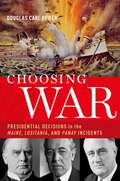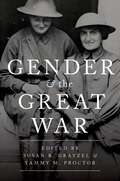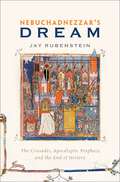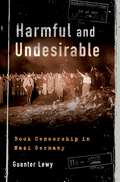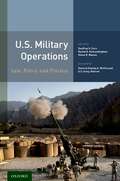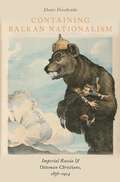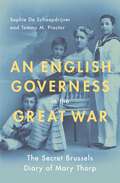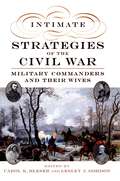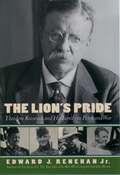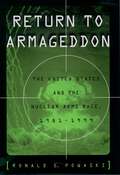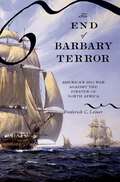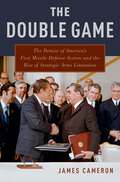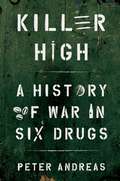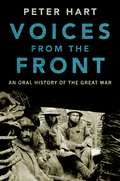- Table View
- List View
Choosing War: Presidential Decisions in the Maine, Lusitania, and Panay Incidents
by Douglas Carl PeiferThroughout US history, presidents have had vastly different reactions to naval incidents. Though some incidents have been resolved diplomatically, others have escalated to outright war. What factors influence the outcome of a naval incident, especially when calls for retribution mingle with recommendations for restraint? Given the rise of long range anti-ship and anti-air missile systems, coupled with tensions in East Asia, the Persian Gulf, and the Black and Baltic Seas, the question is more relevant than ever for US naval diplomacy. In Choosing War, Douglas Carl Peifer compares the ways in which different presidential administrations have responded when American lives were lost at sea. He examines in depth three cases: the Maine incident (1898), which led to war in the short term; the Lusitania crisis (1915), which set the trajectory for intervention; and the Panay incident (1937), which was settled diplomatically. While evaluating Presidents William McKinley, Woodrow Wilson, and Franklin Delano Roosevelt's responses to these incidents, Peifer lucidly reflects on the options they had available and the policies they ultimately selected. The case studies illuminate how leadership, memory, and shifting domestic policy shape presidential decisions, providing significant insights into the connections between naval incidents, war, and their historical contexts. Rich in dramatic narrative and historical perspective, Choosing War offers an essential tool for confronting future naval crises.
Gender and the Great War
by Susan R. Grayzel Tammy M. ProctorThe centenary of the First World War in 2014-18 offers an opportunity to reflect upon the role of gender history in shaping our understanding of this pivotal international event. From the moment of its outbreak, the gendered experiences of the war have been seen by contemporary observers and postwar commentators and scholars as being especially significant for shaping how the war can and must be understood. The negotiating of ideas about gender by women and men across vast reaches of the globe characterizes this modern, instrumental conflict. Over the past twenty-five years, as the scholarship on gender and this war has grown, there has never been a forum such as the one presented here that placed so many of the varying threads of this complex historiography into conversation with one another in a manner that is at once accessible and provocative. Given the vast literature on the war itself, scholarship on gender and various themes and topics provides students as well as scholars with a chance to think not only about the subject of the war but also the methodological implications of how historians have approached it. While many studies have addressed the national or transnational narrative of women in the war, none address both femininity and masculinity, and the experiences of both women and men across the same geographic scope as the studies presented in this volume.
GENDER & THE GREAT WAR C
by Susan R. Grayzel Tammy M. ProctorThe centenary of the First World War in 2014-18 offers an opportunity to reflect upon the role of gender history in shaping our understanding of this pivotal international event. From the moment of its outbreak, the gendered experiences of the war have been seen by contemporary observers and postwar commentators and scholars as being especially significant for shaping how the war can and must be understood. The negotiating of ideas about gender by women and men across vast reaches of the globe characterizes this modern, instrumental conflict. Over the past twenty-five years, as the scholarship on gender and this war has grown, there has never been a forum such as the one presented here that placed so many of the varying threads of this complex historiography into conversation with one another in a manner that is at once accessible and provocative. Given the vast literature on the war itself, scholarship on gender and various themes and topics provides students as well as scholars with a chance to think not only about the subject of the war but also the methodological implications of how historians have approached it. While many studies have addressed the national or transnational narrative of women in the war, none address both femininity and masculinity, and the experiences of both women and men across the same geographic scope as the studies presented in this volume.
Nebuchadnezzar's Dream: The Crusades, Apocalyptic Prophecy, and the End of History
by Jay RubensteinIn 1099, the soldiers of the First Crusade took Jerusalem. As the news of this victory spread throughout Medieval Europe, it felt nothing less than miraculous and dream-like, to such an extent that many believed history itself had been fundamentally altered by the event and that the Rapture was at hand. As a result of military conquest, Christians could see themselves as agents of rather than mere actors in their own salvation. The capture of Jerusalem changed everything. A loosely defined geographic backwater, comprised of petty kingdoms and shifting alliances, Medieval Europe began now to imagine itself as the center of the world. The West had overtaken the East not just on the world's stage but in God's plans. To justify this, its writers and thinkers turned to ancient prophecies, and specifically to one of the most enigmatic passages in the Bible the dream King Nebuchadnezzar has in the Book of Daniel, of a statue with a golden head and feet of clay. Conventional interpretation of the dream transformed the state into a series of kingdoms, each less glorious than the last, leading inexorably to the end of all earthly realms-- in short, to the Apocalypse. The First Crusade signified to Christians that the dream of Nebuchadnezzar would be fulfilled on their terms. Such heady reconceptions continued until the disaster of the Second Crusade and with it, the collapse of any dreams of unification or salvation-any notion that conquering the Holy Land and defeating the Infidel could absolve sin. In Nebuchadnezzar's Dream, Jay Rubenstein boldly maps out the steps by which these social, political, economic, and intellectual shifts occurred throughout the 12th century, drawing on those who guided and explained them. The Crusades raised the possibility of imagining the Apocalypse as more than prophecy but actual event. Rubenstein examines how those who confronted the conflict between prophecy and reality transformed the meaning and memory of the Crusades as well as their place in history.
Nebuchadnezzar's Dream: The Crusades, Apocalyptic Prophecy, and the End of History
by Jay RubensteinIn 1099, the soldiers of the First Crusade took Jerusalem. As the news of this victory spread throughout Medieval Europe, it felt nothing less than miraculous and dream-like, to such an extent that many believed history itself had been fundamentally altered by the event and that the Rapture was at hand. As a result of military conquest, Christians could see themselves as agents of rather than mere actors in their own salvation. The capture of Jerusalem changed everything. A loosely defined geographic backwater, comprised of petty kingdoms and shifting alliances, Medieval Europe began now to imagine itself as the center of the world. The West had overtaken the East not just on the world's stage but in God's plans. To justify this, its writers and thinkers turned to ancient prophecies, and specifically to one of the most enigmatic passages in the Bible the dream King Nebuchadnezzar has in the Book of Daniel, of a statue with a golden head and feet of clay. Conventional interpretation of the dream transformed the state into a series of kingdoms, each less glorious than the last, leading inexorably to the end of all earthly realms-- in short, to the Apocalypse. The First Crusade signified to Christians that the dream of Nebuchadnezzar would be fulfilled on their terms. Such heady reconceptions continued until the disaster of the Second Crusade and with it, the collapse of any dreams of unification or salvation-any notion that conquering the Holy Land and defeating the Infidel could absolve sin. In Nebuchadnezzar's Dream, Jay Rubenstein boldly maps out the steps by which these social, political, economic, and intellectual shifts occurred throughout the 12th century, drawing on those who guided and explained them. The Crusades raised the possibility of imagining the Apocalypse as more than prophecy but actual event. Rubenstein examines how those who confronted the conflict between prophecy and reality transformed the meaning and memory of the Crusades as well as their place in history.
Harmful and Undesirable: Book Censorship in Nazi Germany
by Guenter LewyLike every totalitarian regime, Nazi Germany tried to control intellectual freedom through book censorship. Between 1933 and 1945, the Hitler regime orchestrated a massive campaign to take control of all forms of communication. In 1933 alone, there were 90 book burnings across 70 German cities, declared by a Ministry of Propaganda official to be "a symbol of the revolution." In later years, the regime used less violent means of domination, pillaging bookstores and libraries, in addition to prosecuting uncooperative publishers and dissident authors. Guenter Lewy deftly analyzes the various strategies that the Nazis employed to enact censorship and the government officials who led the attack on a free intellectual life. Harmful and Undesirable paints a fascinating portrait of intellectual life under Nazi dictatorship, detailing the dismal fate of those who were caught in the wheels of censorship.
Harmful and Undesirable: Book Censorship in Nazi Germany
by Guenter LewyLike every totalitarian regime, Nazi Germany tried to control intellectual freedom through book censorship. Between 1933 and 1945, the Hitler regime orchestrated a massive campaign to take control of all forms of communication. In 1933 alone, there were 90 book burnings across 70 German cities, declared by a Ministry of Propaganda official to be "a symbol of the revolution." In later years, the regime used less violent means of domination, pillaging bookstores and libraries, in addition to prosecuting uncooperative publishers and dissident authors. Guenter Lewy deftly analyzes the various strategies that the Nazis employed to enact censorship and the government officials who led the attack on a free intellectual life. Harmful and Undesirable paints a fascinating portrait of intellectual life under Nazi dictatorship, detailing the dismal fate of those who were caught in the wheels of censorship.
U.S. MILITARY OPERATIONS C: Law, Policy, and Practice
by Geoffrey S. Corn, Rachel E. VanLandingham and Shane R. ReevesIn U.S. Military Operations: Law, Policy, and Practice, a distinguished group of military experts comprehensively analyze how the law is applied during military operations on and off the battlefield. Subject matter experts offer a unique insiders perspective on how the law is actually implemented in a wide swath of military activities, such as how the law of war applies in the context of multi-state coalition forces, and whether non-governmental organizations involved in quasi-military operations are subject to the same law. The book goes on to consider whether U.S. Constitutional 4th Amendment protections apply to the military's cyber-defense measures, how the law guides targeting decisions, and whether United Nations mandates constitute binding rules of international humanitarian law. Other areas of focus include how the United States interacts with the International Committee of the Red Cross regarding its international legal obligations, and how courts should approach civil claims based on war-related torts. This book also answers questions regarding how the law of armed conflict applies to such extra-conflict acts as intercepting pirates and providing humanitarian relief to civilians in occupied territory.
Containing Balkan Nationalism: Imperial Russia and Ottoman Christians, 1856-1914 (Religion and Global Politics)
by Denis VovchenkoContaining Balkan Nationalism focuses on the implications of the Bulgarian national movement that developed in the context of Ottoman modernization and of European imperialism in the Near East. The movement aimed to achieve the status of an independent Bulgarian Orthodox church, removing ethnic Bulgarians from the jurisdiction of the Patriarchate of Constantinople. This independent church status meant legal and cultural autonomy within the Islamic structure of the Ottoman Empire, which recognized religious minorities rather than ethnic ones. Denis Vovchenko shows how Russian policymakers, intellectuals, and prelates worked together with the Ottoman government, Balkan and other diplomats, and rival churches, to contain and defuse ethnic conflict among Ottoman Christians through the promotion of supraethnic religious institutions and identities. The envisioned arrangements were often inspired by modern visions of a political and cultural union of Orthodox Slavs and Greeks. Whether realized or not, they demonstrated the strength and flexibility of supranational identities and institutions on the eve of the First World War. The book encourages contemporary analysts and policymakers to explore the potential of such traditional loyalties to defuse current ethnic tensions and serve as organic alternatives to generic models of power-sharing and federation.
An English Governess in the Great War: The SEcret Brussels Diary of Mary Thorp
by Sophie De Schaepdrijver Tammy M. ProctorAn Englishwoman of no particular fame living in World War I Brussels started a secret diary in September 1916. Aware that her thoughts could put her in danger with German authorities, she never wrote her name on the diary and ran to hide it every time the "Boches" came to inspect the house. The diary survived the war and ended up in a Belgian archive, forgotten for nearly a century until historians Sophie De Schaepdrijver and Tammy M. Proctor discovered it and the remarkable woman who wrote it: Mary Thorp, a middle-aged English governess working for a wealthy Belgian-Russian family in Brussels. As a foreigner and a woman, Mary Thorp offers a unique window into life under German occupation in Brussels (the largest occupied city of World War I) and in the uncertain early days of the peace. Her diary describes the roar of cannons in the middle of the night, queues for food and supplies in the shops, her work for a wartime charity, news from an interned godson in Germany, along with elegant dinners with powerful diplomats and the educational progress of her beloved charges. Mary Thorp's sharp and bittersweet reflections testify to the daily strains of living under enemy occupation, comment on the events of the war as they unfolded, and ultimately serve up a personal story of self-reliance and endurance. De Schaepdrijver and Proctor's in-depth commentary situate this extraordinary woman in her complex political, social, and cultural context, thus providing an unusual chance to engage with the Great War on an intimate and personal level.
An English Governess in the Great War: The SEcret Brussels Diary of Mary Thorp
by Tammy M. Proctor Sophie De SchaepdrijverAn Englishwoman of no particular fame living in World War I Brussels started a secret diary in September 1916. Aware that her thoughts could put her in danger with German authorities, she never wrote her name on the diary and ran to hide it every time the "Boches" came to inspect the house. The diary survived the war and ended up in a Belgian archive, forgotten for nearly a century until historians Sophie De Schaepdrijver and Tammy M. Proctor discovered it and the remarkable woman who wrote it: Mary Thorp, a middle-aged English governess working for a wealthy Belgian-Russian family in Brussels. As a foreigner and a woman, Mary Thorp offers a unique window into life under German occupation in Brussels (the largest occupied city of World War I) and in the uncertain early days of the peace. Her diary describes the roar of cannons in the middle of the night, queues for food and supplies in the shops, her work for a wartime charity, news from an interned godson in Germany, along with elegant dinners with powerful diplomats and the educational progress of her beloved charges. Mary Thorp's sharp and bittersweet reflections testify to the daily strains of living under enemy occupation, comment on the events of the war as they unfolded, and ultimately serve up a personal story of self-reliance and endurance. De Schaepdrijver and Proctor's in-depth commentary situate this extraordinary woman in her complex political, social, and cultural context, thus providing an unusual chance to engage with the Great War on an intimate and personal level.
Intimate Strategies of the Civil War: Military Commanders and Their Wives
by CAROL K. BLESER AND LESLEY J. GORDONFrom Robert E. and Mary Lee to Ulysses S. and Julia Grant, Intimate Strategies of the Civil War examines the marriages of twelve prominent military commanders, highlighting the impact wives had on their famous husbands' careers. Carol K. Bleser and Lesley J. Gordon assemble an impressive array of leading scholars to explore the marriages of six Confederate and six Union commanders. Contributors reveal that, for many of these men, the matrimonial bond was the most important relationship in their lives, one that shaped (and was shaped by) their military experience. In some cases, the commanders' spouses proved relentless and skillful promoters of their husbands' careers. Jessie Frémont drew on all of her connections as the daughter of former Senator Thomas Hart Benton to aid her modestly talented husband John. Others bolstered their military spouses in less direct ways. For example, Ulysses S. Grant's relationship with Julia (a Southerner and former slave owner herself) kept him anchored in stormy times. Here, too, are tense and tempestuous pairings, such William Tecumseh Sherman and his wife Ellen--his foster sister before becoming his wife--and Jefferson Davis's fascinatingly complex bond with Varina, further complicated by the hostile rumors about the two in Richmond society. Throughout, these historians paint remarkably intimate portraits of their subjects. Readers will see these famed men in a way that they perhaps never considered: not merely as famous leaders, but as lovers, husbands and fathers.
The Lion's Pride: Theodore Roosevelt and His Family in Peace and War
by Edward J. RenehanIn The Lion's Pride, Edward J. Renehan, Jr. vividly portrays the grand idealism, heroic bravery, and reckless abandon that Theodore Roosevelt both embodied and bequeathed to his children and the tragic fulfillment of that legacy on the battlefields of World War I. Drawing upon a wealth of previously unavailable materials, including letters and unpublished memoirs, The Lion's Pride takes us inside what is surely the most extraordinary family ever to occupy the White House. Theodore Roosevelt believed deeply that those who had been blessed with wealth, influence, and education were duty bound to lead, even--perhaps especially--if it meant risking their lives to preserve the ideals of democratic civilization. Teddy put his principles, and his life, to the test in the Spanish American war, and raised his children to believe they could do no less. When America finally entered the "European conflict" in 1917, all four of his sons eagerly enlisted and used their influence not to avoid the front lines but to get there as quickly as possible. Their heroism in France and the Middle East matched their father's at San Juan Hill. All performed with selfless--some said heedless--courage: Two of the boys, Archie and Ted, Jr., were seriously wounded, and Quentin, the youngest, was killed in a dogfight with seven German planes. Thus, the war that Teddy had lobbied for so furiously brought home a grief that broke his heart. He was buried a few months after his youngest child. Filled with the voices of the entire Roosevelt family, The Lion's Pride gives us the most intimate and moving portrait ever published of the fierce bond between Teddy Roosevelt and his remarkable children.
Return to Armageddon: The United States and the Nuclear Arms Race, 1981-1999
by Ronald E. PowaskiWhen the Cold War ended, the world let out a collective sigh of relief as the fear of nuclear confrontation between superpowers appeared to vanish overnight. As we approach the new millennium, however, the proliferation of nuclear weapons to ever more belligerent countries and factions raises alarming new concerns about the threat of nuclear war. In Return to Armageddon, Ronald Powaski assesses the dangers that beset us as we enter an increasingly unstable political world. With the START I and II treaties, completed by George Bush in 1991 and 1993 respectively, and the Comprehensive Test Ban Treaty (CTBT), signed by Bill Clinton in 1996, it seemed as if the nuclear clock had been successfully turned back to a safer hour. But Powaski shows that there is much less reason for optimism than we may like to think. Continued U.S.-Russian cooperation can no longer be assured. To make matters worse, Russia has not ratified the START II Treaty and the U.S. Senate has failed to approve the CTBT. Perhaps even more ominously, the effort to prevent the acquisition of nuclear weapons by nonweapon states is threatened by nuclear tests conducted by India and Pakistan. The nuclear club is growing and its most recent members are increasingly hostile. Indeed, it is becoming ever more difficult to keep track of the expertise and material needed to build nuclear weapons, which almost certainly will find their way into terrorist hands. Accessible, authoritative, and provocative, Return to Armageddon provides both a comprehensive account of the arms control process and a startling reappraisal of the nuclear threat that refuses to go away.
The End of Barbary Terror: America's 1815 War against the Pirates of North Africa
by Frederick C. LeinerWhen Barbary pirates captured an obscure Yankee sailing brig off the coast of North Africa in 1812, enslaving eleven American sailors, President James Madison sent the largest American naval force ever gathered to that time, led by the heroic Commodore Stephen Decatur, to end Barbary terror once and for all. Drawing upon numerous ship logs, journals, love letters, and government documents, Frederick C. Leiner paints a vivid picture of the world of naval officers and diplomats in the early nineteenth century, as he recreates a remarkable and little known episode from the early American republic. Leiner first describes Madison's initial efforts at diplomacy, sending Mordecai Noah to negotiate. But when the ruler refused to ransom the Americans--"not for two millions of dollars"--Madison declared war and sent a fleet to North Africa. Decatur's squadron dealt quick blows to the Barbary navy, dramatically fighting and capturing two ships. Decatur then sailed to Algiers. He refused to go ashore to negotiate--indeed, he refused to negotiate on any essential point. The ruler of Algiers signed the treaty--in Decatur's words, "dictated at the mouths of our cannon"--in twenty-four hours. The United States would never pay tribute to the Barbary world again, and the captive Americans were set free. Here then is a real-life naval adventure that will thrill fans of Patrick O'Brian, a story of Islamic terrorism, white slavery, poison gas, diplomatic intrigue, and battles with pirates on the high seas.
The Double Game: The Demise of America's First Missile Defense System and the Rise of Strategic Arms Limitation
by James CameronHow did the United States move from a position of nuclear superiority over the Soviet Union at the beginning of the 1960s to one of nuclear parity under the doctrine of mutual assured destruction in 1972? Drawing on declassified records of conversations three presidents had with their most trusted advisors, James Cameron offers an original answer to this question. John F. Kennedy, Lyndon Johnson, and Richard Nixon struggled to reconcile their personal convictions about the nuclear arms race with the views of the public and Congress. In doing so they engaged in a double game, hiding their true beliefs behind a façade of strategic language while grappling in private with the complex realities of the nuclear age. Cameron shows how, despite reservations about the nuclear buildup, Kennedy and Johnson pushed ahead with an anti-ballistic missile (ABM) system for the United States, fearing the domestic political consequences of scrapping both the system and the popular doctrine of strategic superiority that underpinned it. By contrast, the abrupt decline in US public and congressional support in 1969 forced Nixon to give up America's first ABM and the US lead in offensive ballistic missiles through agreements with the Soviet Union, despite his conviction that the US needed a nuclear edge to maintain the security of the West. By placing this dynamic at the center of the story, The Double Game provides a new overarching interpretation of this pivotal period in the development of US nuclear policy and a window onto current debates over nuclear superiority, deterrence, and the future of American grand strategy.
The Double Game: The Demise of America's First Missile Defense System and the Rise of Strategic Arms Limitation
by James CameronHow did the United States move from a position of nuclear superiority over the Soviet Union at the beginning of the 1960s to one of nuclear parity under the doctrine of mutual assured destruction in 1972? Drawing on declassified records of conversations three presidents had with their most trusted advisors, James Cameron offers an original answer to this question. John F. Kennedy, Lyndon Johnson, and Richard Nixon struggled to reconcile their personal convictions about the nuclear arms race with the views of the public and Congress. In doing so they engaged in a double game, hiding their true beliefs behind a façade of strategic language while grappling in private with the complex realities of the nuclear age. Cameron shows how, despite reservations about the nuclear buildup, Kennedy and Johnson pushed ahead with an anti-ballistic missile (ABM) system for the United States, fearing the domestic political consequences of scrapping both the system and the popular doctrine of strategic superiority that underpinned it. By contrast, the abrupt decline in US public and congressional support in 1969 forced Nixon to give up America's first ABM and the US lead in offensive ballistic missiles through agreements with the Soviet Union, despite his conviction that the US needed a nuclear edge to maintain the security of the West. By placing this dynamic at the center of the story, The Double Game provides a new overarching interpretation of this pivotal period in the development of US nuclear policy and a window onto current debates over nuclear superiority, deterrence, and the future of American grand strategy.
Killer High: A History of War in Six Drugs
by Peter AndreasThere is growing alarm over how drugs empower terrorists, insurgents, militias, and gangs. But by looking back not just years and decades but centuries, Peter Andreas reveals that the drugs-conflict nexus is actually an old story, and that powerful states have been its biggest beneficiaries. In his path-breaking Killer High, Andreas shows how six psychoactive drugs-ranging from old to relatively new, mild to potent, licit to illicit, natural to synthetic-have proven to be particularly important war ingredients. This sweeping history tells the story of war from antiquity to the modern age through the lens of alcohol, tobacco, caffeine, opium, amphetamines, and cocaine. Beer and wine drenched ancient and medieval battlefields, and the distilling revolution lubricated the conquest and ethnic cleansing of the New World. Tobacco became globalized through soldiering, with soldiers hooked on smoking and governments hooked on taxing it. Caffeine and opium fueled imperial expansion and warfare. The commercialization of amphetamines in the twentieth century energized soldiers to fight harder, longer, and faster, while cocaine stimulated an increasingly militarized drug war that produced casualty numbers surpassing most civil wars. As Andreas demonstrates, armed conflict has become progressively more drugged with the introduction, mass production, and global spread of mind-altering substances. As a result, we cannot understand the history of war without including drugs, and we similarly cannot understand the history of drugs without including war. From ancient brews and battles to meth and modern warfare, drugs and war have grown up together and become addicted to each other.
Killer High: A History of War in Six Drugs
by Peter AndreasThere is growing alarm over how drugs empower terrorists, insurgents, militias, and gangs. But by looking back not just years and decades but centuries, Peter Andreas reveals that the drugs-conflict nexus is actually an old story, and that powerful states have been its biggest beneficiaries. In his path-breaking Killer High, Andreas shows how six psychoactive drugs-ranging from old to relatively new, mild to potent, licit to illicit, natural to synthetic-have proven to be particularly important war ingredients. This sweeping history tells the story of war from antiquity to the modern age through the lens of alcohol, tobacco, caffeine, opium, amphetamines, and cocaine. Beer and wine drenched ancient and medieval battlefields, and the distilling revolution lubricated the conquest and ethnic cleansing of the New World. Tobacco became globalized through soldiering, with soldiers hooked on smoking and governments hooked on taxing it. Caffeine and opium fueled imperial expansion and warfare. The commercialization of amphetamines in the twentieth century energized soldiers to fight harder, longer, and faster, while cocaine stimulated an increasingly militarized drug war that produced casualty numbers surpassing most civil wars. As Andreas demonstrates, armed conflict has become progressively more drugged with the introduction, mass production, and global spread of mind-altering substances. As a result, we cannot understand the history of war without including drugs, and we similarly cannot understand the history of drugs without including war. From ancient brews and battles to meth and modern warfare, drugs and war have grown up together and become addicted to each other.
WAR & INDIVIDUAL RIGHTS C: The Foundations of Just War Theory
by Kai DraperKai Draper begins his book with the assumption that individual rights exist and stand as moral obstacles to the pursuit of national no less than personal interests. That assumption might seem to demand a pacifist rejection of war, for any sustained war effort requires military operations that predictably kill many noncombatants as "collateral damage," and presumably at least most noncombatants have a right not to be killed. Yet Draper ends with the conclusion that sometimes recourse to war is justified. In making his argument, he relies on the insights of John Locke to develop and defend a framework of rights to serve as the foundation for a new just war theory. Notably missing from that framework is any doctrine of double effect. Most just war theorists rely on that doctrine to justify injuring and killing innocent bystanders, but Draper argues that various prominent formulations of the doctrine are either untenable or irrelevant to the ethics of war. Ultimately he offers a single principle for assessing whether recourse to war would be justified. He also explores in some detail the issue of how to distinguish discriminate from indiscriminate violence in war, arguing that some but not all noncombatants are liable to attack.
Voices from the Front: An Oral History of the Great War
by Peter HartIn the 1980s and early 1990s, Peter Hart, then a young oral historian at the Imperial War Museum in London, conducted 183 interviews with British World War I veterans. After the death of the last veteran in 2009, these interviews have become a rare and invaluable record of the Great War, as remembered by the men who experienced it. The men spoke to Hart of the familiar horrors of the war-poison gas, lice, muddy trenches, newly minted tanks, and sinking ships-enriching each memory with personal anecdote, shedding light on war's effect on soldiers both in wartime and during the years that followed. Hart now returns to these interviews in Voices from the Front. His new book not only provides a narrative timeline of the events of 1914 to 1918, but restores individuality and humanity to the men who were often treated like expendable resources. Hart uses the transcripts of these conversations as a framework on which to build a unique depiction of Britain's experience of the war-one separated from the boastful exaggerations or, alternatively, the underplaying euphemisms often found in letters mailed home or to fellow soldiers. By including the testimonies of men such as William Holbrook, who was just 15 when he enlisted, as well as Harold Bing, an anti-war demonstrator, Hart breathes new life into the experiences of both young soldiers and those who morally opposed the war. The result is history as both narrative and recollection; war experienced first-hand but looked at now from a great distance. Here is an intimate and humanized account of the first great cataclysm of the twentieth century, one endured by the men whose voices we hear in this book, and whose legacies are with us still.
Voices from the Front: An Oral History of the Great War
by Peter HartIn the 1980s and early 1990s, Peter Hart, then a young oral historian at the Imperial War Museum in London, conducted 183 interviews with British World War I veterans. After the death of the last veteran in 2009, these interviews have become a rare and invaluable record of the Great War, as remembered by the men who experienced it. The men spoke to Hart of the familiar horrors of the war-poison gas, lice, muddy trenches, newly minted tanks, and sinking ships-enriching each memory with personal anecdote, shedding light on war's effect on soldiers both in wartime and during the years that followed. Hart now returns to these interviews in Voices from the Front. His new book not only provides a narrative timeline of the events of 1914 to 1918, but restores individuality and humanity to the men who were often treated like expendable resources. Hart uses the transcripts of these conversations as a framework on which to build a unique depiction of Britain's experience of the war-one separated from the boastful exaggerations or, alternatively, the underplaying euphemisms often found in letters mailed home or to fellow soldiers. By including the testimonies of men such as William Holbrook, who was just 15 when he enlisted, as well as Harold Bing, an anti-war demonstrator, Hart breathes new life into the experiences of both young soldiers and those who morally opposed the war. The result is history as both narrative and recollection; war experienced first-hand but looked at now from a great distance. Here is an intimate and humanized account of the first great cataclysm of the twentieth century, one endured by the men whose voices we hear in this book, and whose legacies are with us still.
The Path to War: How the First World War Created Modern America
by Michael S. NeibergWhen war broke out in Europe in August of 1914, it seemed, to observers in the United States, the height of madness. The Old World and its empires were tearing each other apart, and while most Americans blamed the Germans, pitied the Belgians, and felt kinship with the Allies, they wanted no part in the carnage. Two years into war President Woodrow Wilson won re-election by pledging to keep out of the conflict. Yet by the spring of 1917-by which point millions had been killed for little apparent gain or purpose-the fervor to head "Over There" swept the country. America wanted in. The Path to War shows us how that happened. Entry into the war resulted from lengthy debate and soul-searching about national identity, as so-called "hyphenated citizens" of Irish and German heritage wrestled with what it meant to be American. Many hoped to keep to the moral high ground, condemning German aggression while withholding from the Allies active support, offering to mediate between the belligerents while keeping clear. Others, including the immensely popular former president Theodore Roosevelt, were convinced that war offered the country the only way to assume its rightful place in world affairs. Neiberg follows American reaction to such events as the sinking of the Lusitania, German terrorism, and the incriminating Zimmermann telegram, shedding light on the dilemmas and crises the country faced as it moved from ambivalence to belligerence. As we approach the centenary of the war, the effects of the pivot from peace to war still resonate, as Michael Neiberg's compelling book makes clear. The war transformed the United States into a financial powerhouse and global player, despite the reassertion of isolationism in the years that followed. Examining the social, political, and financial forces at work as well as the role of public opinion and popular culture, The Path to War offers both a compelling narrative and the inescapable conclusion that World War One was no parenthetical exception in the American story but a moment of national self-determination.
The Path to War: How the First World War Created Modern America
by Michael S. NeibergWhen war broke out in Europe in August of 1914, it seemed, to observers in the United States, the height of madness. The Old World and its empires were tearing each other apart, and while most Americans blamed the Germans, pitied the Belgians, and felt kinship with the Allies, they wanted no part in the carnage. Two years into war President Woodrow Wilson won re-election by pledging to keep out of the conflict. Yet by the spring of 1917-by which point millions had been killed for little apparent gain or purpose-the fervor to head "Over There" swept the country. America wanted in. The Path to War shows us how that happened. Entry into the war resulted from lengthy debate and soul-searching about national identity, as so-called "hyphenated citizens" of Irish and German heritage wrestled with what it meant to be American. Many hoped to keep to the moral high ground, condemning German aggression while withholding from the Allies active support, offering to mediate between the belligerents while keeping clear. Others, including the immensely popular former president Theodore Roosevelt, were convinced that war offered the country the only way to assume its rightful place in world affairs. Neiberg follows American reaction to such events as the sinking of the Lusitania, German terrorism, and the incriminating Zimmermann telegram, shedding light on the dilemmas and crises the country faced as it moved from ambivalence to belligerence. As we approach the centenary of the war, the effects of the pivot from peace to war still resonate, as Michael Neiberg's compelling book makes clear. The war transformed the United States into a financial powerhouse and global player, despite the reassertion of isolationism in the years that followed. Examining the social, political, and financial forces at work as well as the role of public opinion and popular culture, The Path to War offers both a compelling narrative and the inescapable conclusion that World War One was no parenthetical exception in the American story but a moment of national self-determination.
Morale: A Modern British History
by Daniel UssishkinArguably no nation is as closely associated with the term morale as Great Britain. Yet this concept that seems so innate to the British people was carefully cultivated within many spheres of modern national life. In this first critical history of morale, Daniel Ussishkin asks how is it that modern Britons have come to regard morale as a category of conduct, vital for the success of collective effort in war and peace, and a mark of good, modern, and human managerial practice, appropriate for a democratic age. He narrates the intellectual, cultural, and institutional history of morale in modern imperial Britain: its emergence as a new concept during the long nineteenth century, its changing meanings and significations, and the social and political goals those who discussed, observed, or managed morale sought to achieve. Formalized as a new military disciplinary problem during the long nineteenth century, morale came to permeate nearly every civilian sphere of life during the era of the two world wars as a new way of managing human conduct. This book traces how it gradually emerged from a problem that was regarded as residual at best to one that was seen as the epitome of proper managerial practice, its institutional manifestations and promotion by myriad organizations and the social-democratic state, and its emergence as a potent political concept from Britain's social-democratic moment until the ascendancy of the New Right. Daniel Ussishkin's Morale tells the history of concept central to the management of war, business, and civic society not just in Britain but in modern culture writ large.
